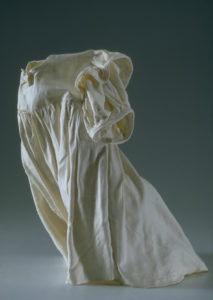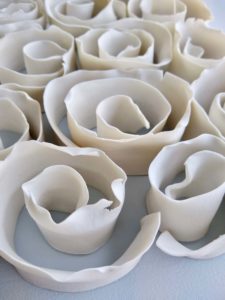 Proud
Proud
Tiziana Bendall-Brunello
1999
Porcelain
39 cm x 24 cm x 24 cm
Tiziana Bendall-Brunello’s sculpture “Proud” is a Victorian children’s dress in unglazed porcelain. The artist dipped the wear in liquid porcelain and modelled it. By the firing at a very high temperature, the material becomes extremely light and translucent. However, the resulting colour is natural white like unbleached cotton. Instead of presenting the gown as simply spread textile, Tiziana treated it as if there would be a body in it. The chest of dress is slightly bent forward, the non-existing left leg seems to be the vertical positioned supporting one, the right free leg is inclined backwards and the back of the skirt repeats this movement. By this modulation, the dress apparently strides forward. This movement is underlined by the extensions at the shoulders and the slightly backwards orientated sleeves.
Due to the material, the sculpture has a bony fossil-like look, which reminds antique marble sculptures. Moreover, its posture, shape and the non-existing arms and head evoke the antique sculpture of the “Nike of Samothrace“, which depicts the winged goddess of Victory found on the island Samothrace. Though, there are differences. The leg position is conversed and the wings are missing. More eminent is the concept of body and clothes. Nike wears her garments to accentuate the body by the wet-effect tight clothing. Whereas Tiziana’s sculpture only consists of the dress. Additionally, “Proud” is not to compare with stiff early medieval sculptures. Here the draped habit is like an armour, which conceals the body and head, hands and feed seem to be only attached. Nor is to think of the early Renaissance paintings for example Botticelli’s Flora in “Primavera” and “The Birth of Venus“. Here Flora is surrounded by her ballooned dress that shows the posture but not really the body.
Although, Tiziana only features the gown, the sculpture appears lively as if the wearer slipped out just a moment ago, left alone like a second skin. In doing so, the artists reverses the development of body conception in art history. After antiquity, the human body was wedged in its recess and clothes like a column. With the time, the sculptures gained more space, but still they were trapped in their alcoves. Only in the Renaissance and even more in the Baroque human representations started to be freestanding, extensive and independent. However, at this time the sculptures have lost their clothing and were mostly nude. Here starts Tiziana’s intervention: “Proud” is a little bit as if she has taken a dress of a vivid sculpture and positioned it as if the body would still be in.
Already the posture of the sculpture conveys self-confidence by the advanced upper body and the purposeful stride forward. Regarding the title of the oeuvre “Proud”, it looks like an illustration of the German expression, which describes proud people as with a chest swollen by pride. Since it seems to be a woman dress, it could refer to self-confident women. One might also think of its origin in the Victorian era and evoke the long reign of Queen Victoria, who was all but a feminist. Nevertheless, women have successfully fought for their rights during her rule: a first College for Women was founded, women obtained a right to personal property after divorce and a limited women’s suffrage was gained. This should be something to be proud of.
Another aspect is the fact that the modified gown is a children’s dress. This might be owed to an easier handling because of the smaller size. Additionally it is perhaps neglectable, since children of the middle and upper class were dressed similar to adults. On the other hand, Tiziana wrote several children’s books. Therefore, she might have had the extended access to education during the Victorian era in mind. Even poor children conditionally could go to broad schools. A result of this better education might be the development of a stronger self-confidence in the following generations, who could look ahead with pride. Last but not least, Tiziana’s adopted country is Great Britain. The choice of a garment of its history could be tribute to her new home, but formulated 11 years ago.
Tiziana Bendall-Brunello
Born in 1959 in Turin, Italy, Tiziana studied Fine Arts and Ceramics at the Camberwell College of Arts under the tutelage of Richard Slee, with visiting lecturers such as Damien Hirst and Jonathon Miller. During her studies, her artistic practice guided her to experiment with glass. Consequently, she did a short course in Architectural Glass at Wolverhampton University after her degree in London.
From early on, Tiziana was interested in the human body and the idea that clothes surround it like a second skin. Inspired by the works of the Arte Povera artist Giuseppe Penone, who questioned the relationship between the human body and the external environment, she researched to find her own expression. Having in mind the nude sculptures often found in Renaissance works and in Antiquity, she reversed the representation of the human body by its absence. She created a large series of porcelain-dipped children’s dresses. “Proud”, one oeuvre from this period around the year 2000 is our artwork of the month for October 2020.
While working with glass, Tiziana included a variety of metals such as copper, aluminium, silver and gold leaf. Additionally, she encapsulated fragments of her dress-series into fused glass. Here the artist superimposed two delicate materials referring at the same time to the fragility of the human body. In other works, she used mixed-media techniques. Thereby she integrated inter-alia one of her other preferred artistic forms, photography. Often she took a pre-existing form as the point of departure, for example tea-bags, which she puts in a broader context.
 In her latest works, Tiziana has a different approach. She creates flowing, organic, delicately constructed forms. As echoes of natural structures, they grow like flowers out of their initial arrangements and almost develop an independent existence. An example of these vital and lively sculpture series is “Blossoming” – a collection of porcelain spirals.
In her latest works, Tiziana has a different approach. She creates flowing, organic, delicately constructed forms. As echoes of natural structures, they grow like flowers out of their initial arrangements and almost develop an independent existence. An example of these vital and lively sculpture series is “Blossoming” – a collection of porcelain spirals.
Most recently, these new oeuvres were shown in Tiziana’s solo exhibition in the Atelier Pecheur de Lune in Cotignac, France. Soon they will be on view in the 109 Gallery in Nice, France (23 – 30 October 2020). For more than 30 years, the artist has participated in numerous exhibitions in Great Britain, France, Italy and Germany. Moreover, she was represented at many art fairs in Europe and the United States. Her works are shown in the collection of MIAAO (Museo Internazionale d’Arti Applicate Oggi) Turin, Italy and in the Castellamonte Museum, Italy.
Tiziana lives and works in Cambridge, UK and Cannes, France.
